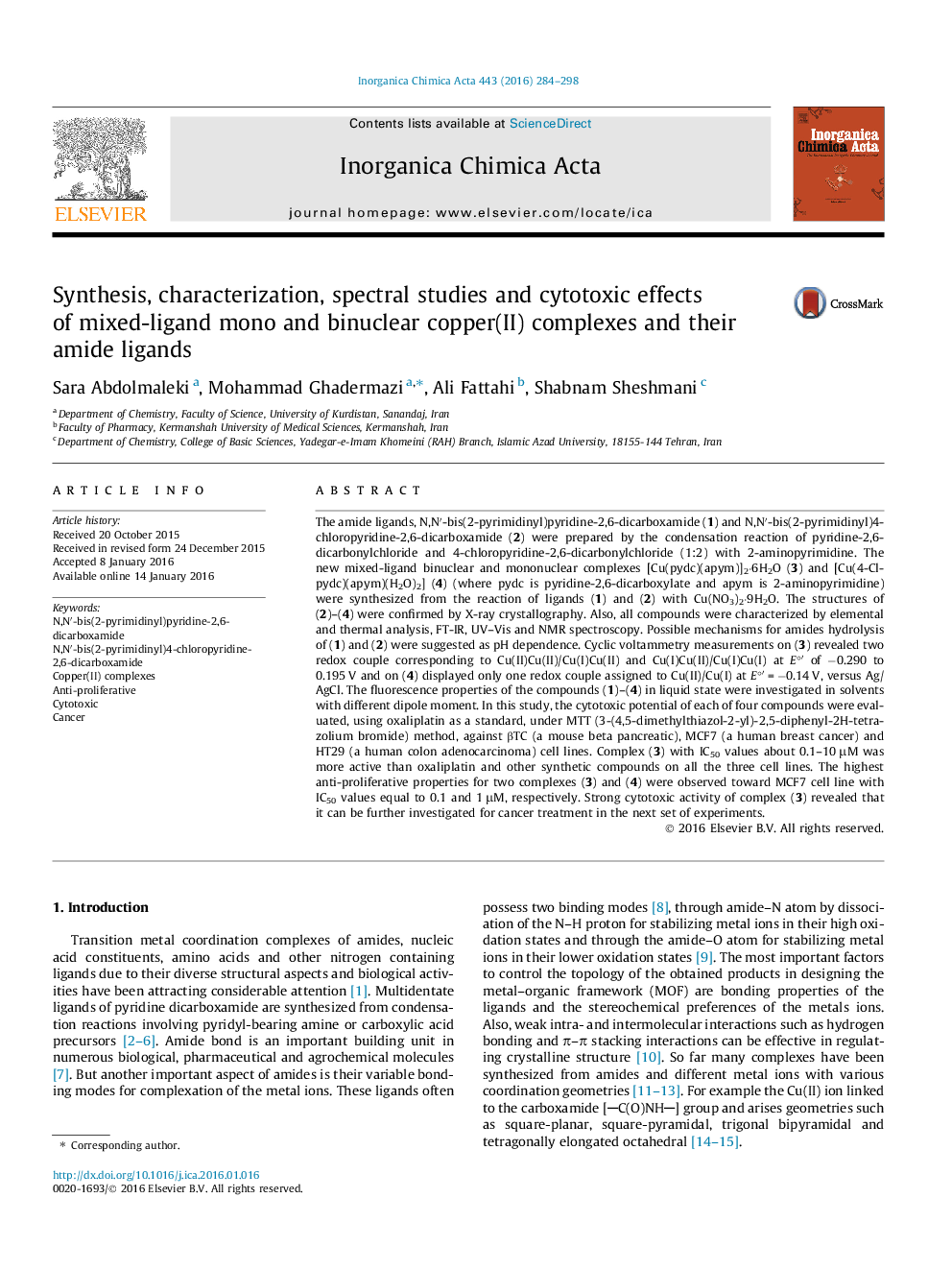| Article ID | Journal | Published Year | Pages | File Type |
|---|---|---|---|---|
| 1306446 | Inorganica Chimica Acta | 2016 | 15 Pages |
•Novel mixed-ligand Cu(II) complexes and an amide ligand have been synthesized and characterized.•Mechanisms for hydrolysis of ligands were suggested.•Electrochemical properties of the complexes were studied.•The fluorescence properties of the compounds were investigated in solvents with different dipole moment.•Cytotoxic activity of the compounds against three cell lines were checked.
The amide ligands, N,N′-bis(2-pyrimidinyl)pyridine-2,6-dicarboxamide (1) and N,N′-bis(2-pyrimidinyl)4-chloropyridine-2,6-dicarboxamide (2) were prepared by the condensation reaction of pyridine-2,6-dicarbonylchloride and 4-chloropyridine-2,6-dicarbonylchloride (1:2) with 2-aminopyrimidine. The new mixed-ligand binuclear and mononuclear complexes [Cu(pydc)(apym)]2·6H2O (3) and [Cu(4-Cl-pydc)(apym)(H2O)2] (4) (where pydc is pyridine-2,6-dicarboxylate and apym is 2-aminopyrimidine) were synthesized from the reaction of ligands (1) and (2) with Cu(NO3)2·9H2O. The structures of (2)–(4) were confirmed by X-ray crystallography. Also, all compounds were characterized by elemental and thermal analysis, FT-IR, UV–Vis and NMR spectroscopy. Possible mechanisms for amides hydrolysis of (1) and (2) were suggested as pH dependence. Cyclic voltammetry measurements on (3) revealed two redox couple corresponding to Cu(II)Cu(II)/Cu(I)Cu(II) and Cu(I)Cu(II)/Cu(I)Cu(I) at E°′ of −0.290 to 0.195 V and on (4) displayed only one redox couple assigned to Cu(II)/Cu(I) at E°′ = −0.14 V, versus Ag/AgCl. The fluorescence properties of the compounds (1)–(4) in liquid state were investigated in solvents with different dipole moment. In this study, the cytotoxic potential of each of four compounds were evaluated, using oxaliplatin as a standard, under MTT (3-(4,5-dimethylthiazol-2-yl)-2,5-diphenyl-2H-tetrazolium bromide) method, against βTC (a mouse beta pancreatic), MCF7 (a human breast cancer) and HT29 (a human colon adenocarcinoma) cell lines. Complex (3) with IC50 values about 0.1–10 μM was more active than oxaliplatin and other synthetic compounds on all the three cell lines. The highest anti-proliferative properties for two complexes (3) and (4) were observed toward MCF7 cell line with IC50 values equal to 0.1 and 1 μM, respectively. Strong cytotoxic activity of complex (3) revealed that it can be further investigated for cancer treatment in the next set of experiments.
Graphical abstractMixed-ligand copper(II) complexes (3) and (4) have been synthesized by hydrolysis of ligands (1) and (2) respectively. The compounds (1)–(4) were fully characterized by spectroscopic methods. Also the crystal structures of compounds (2)–(4) were determined. Electrochemical properties of complexes and effect of solvent polarity on fluorescence intensity of compounds have been studied. The most intense of fluorescence is observed with complex (4). The compounds (1)–(4) have been evaluated for their cytotoxic potential against βTC, MCF7 and HT29 cell lines. Binuclear copper complex (3) with IC50 values about 0.1–10 μM exhibited the highest anti-proliferative effect on all the three cell lines.Figure optionsDownload full-size imageDownload as PowerPoint slide
